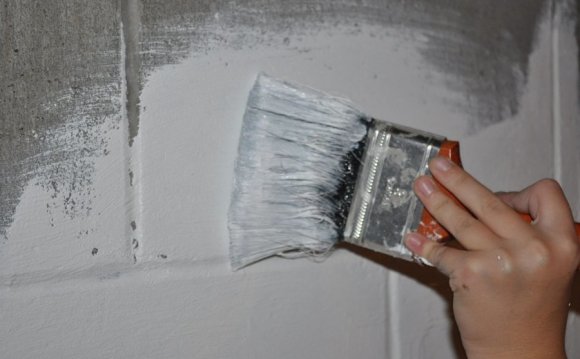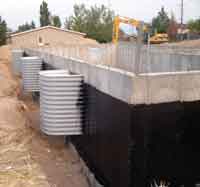
Easy, DIY Waterproofing Solutions That Will Last
Wet or damp basements are the most frequent complaint of homeowners. Traditional, decades-old basement waterproofing methods have not passed the test of time: "Over 60 per cent of basements have moisture seepage in one form or another, while 38 per cent experience mold and fungus growth due to an elevated moisture level." – The American Society of Home Inspectors. Slab-on-grade buildings suffer similar moisture problems. Now, there is a better solution!
Improving Your Home's Health – For over 15 years our RadonSeal® Permanent Concrete Sealer, DIY Crack Injection Kits, and basement waterproofing and radon mitigating products have proven to be the ideal solution for permanently waterproofing wet foundation walls, concrete floors and improving the overall health of your basement and home. Our unique, high-strength, basement waterproofing materials continue to be trusted by professionals and DIY homeowners alike.
The Permanent Concrete Sealer – RadonSeal® is not "your father's" waterproofing paint or sealer. RadonSeal differs from paints and membrane coatings by penetrating deep inside concrete (up to 4"), chemically reacting with lime and alkalis, expanding inside microscopic pores, and curing as a hard mineral. Once cured, RadonSeal will seal your concrete internally against the transmission of water seepage, water vapor and strong enough to seal against harmful radon gas.
Why Basements Start Leaking Water
A hard driving rainstorm or melting snow can temporarily raises the groundwater level and for every inch of rain, a 1, 500 sq. ft. roof sheds almost 1, 000 gallons of water. Rain gutters and downspouts get plugged up with debris. New houses have a problem with "reverse grading, " which usually occurs several years after construction. Fill dirt around the foundation settles and directs rainwater right to the foundation.
As the run-off seeps through the soft topsoil around the house, it pushes against the walls and stops at the undisturbed ground just beneath the footings. Footing drains may break as the house settles, or silt up. If the soil is clay, water then starts rising in the disturbed soil around the foundation like inside a pool.
 Hydrostatic Pressure – When water accumulates around the foundation, hydrostatic pressure builds up and causes the basement to leak. Clay-rich soils do not drain well and hold rainwater right against the foundation walls. Water pushes its way inside through any cracks or joints and the pores in concrete. Rising groundwater is sometimes the problem or even an underground spring. Houses settle and underground water flows change. New construction down the street may shift groundwater flows and cause basement leaks in your house.
Hydrostatic Pressure – When water accumulates around the foundation, hydrostatic pressure builds up and causes the basement to leak. Clay-rich soils do not drain well and hold rainwater right against the foundation walls. Water pushes its way inside through any cracks or joints and the pores in concrete. Rising groundwater is sometimes the problem or even an underground spring. Houses settle and underground water flows change. New construction down the street may shift groundwater flows and cause basement leaks in your house.
Settling Cracks – As houses settle, concrete develops stress cracks that leak water. Exterior waterproofing disintegrates or separates due to the "alkali attack." When water gets to imbedded steel, it rusts, expands and cracks the concrete.
Efflorescence Signifies Water Seepage – Water penetrates into the pores in concrete, dissolves alkalis, and enlarges the pores. As concrete ages, it becomes more and more porous. Initially, the seeping water evaporates, leaving on the surface salts and lime. This "white deposit" or efflorescence is a telltale sign of capillary water seepage.
Plastic Barriers Do Not Last – Concrete slabs, although much thinner than basement walls get even less waterproofing protection. The plastic "vapor barrier" soon disintegrates due to the lime in concrete and over time, the layer of gravel ("drainage pad") silts up. Then, the concrete starts pulling in groundwater by capillary action.
Why Exterior Waterproofing Does Not Last
Tar Waterproofing Is Brittle – Tar waterproofing has absolutely no "give" and cracks as the concrete constantly contracts and expands, and as the house settles. Similarly, tar paper or pargeting (a layer of mortar) on block walls are inelastic and crack.
 Concrete is "very strongly alkaline" (pH above 9). Water carries dissolved alkalis to its surface, where they attack any waterproofing coating by saponification ("alkali attack") and even the concrete itself. Alkaline soils in some regions speed up this process and can "eat" away inches of concrete over several years.
Concrete is "very strongly alkaline" (pH above 9). Water carries dissolved alkalis to its surface, where they attack any waterproofing coating by saponification ("alkali attack") and even the concrete itself. Alkaline soils in some regions speed up this process and can "eat" away inches of concrete over several years.
All waterproofing coatings gradually break down or separate, even flexible elastomeric liquid membranes. Elastomeric sheet membranes separate as the alkalis attack the primer and taped joints - they are guaranteed for only 5 to 10 years.
In the end, the concrete is on its own! It may continue to do a good job for several years but water will gradually activate alkalis, leach out the concrete, and enlarge the pores, making water seepage inevitable. Water is the root problem – in perfectly dry conditions, concrete and waterproofing would last forever.
Wouldn't it be great to somehow stop water migration by internally sealing the pores and to neutralize the alkalis in concrete surface to protect the concrete and any waterproofing coating against "alkali attack"?
That's exactly what RadonSeal does!
How To Waterproof Your Basement in 4-Steps
Tackling a basement waterproofing project can prove to be daunting task but the labor involved may not be as strenous as you thought. Follow this basic step-by-step approach for drying out your damp basment:
STEP 1: Remove any paints, sealers, tile adhesive, efforescence, and oils from the concrete.
STEP 2: Shop-vac the surface of the concrete removing loose or crumbling concrete, mortar, dust, and dirt.
STEP 3: Seal the concrete walls and floor against moisture with RadonSeal®. You can move all your "stuff" to one side of the basement and seal the other side first. Let the concrete dry out for a couple days and then, seal the other side.
STEP 4: Make any repairs to foundation cracks, floor cracks, gaps, control joints, floor-to-wall joints, etc.
How To Seal An Stone Foundation Wall – RadonSeal will strengthen and waterproof old mortar as well as limestone. Remove crumbling mortar then, seal with RadonSeal. Afterwards, tuck point the mortar where needed. RadonSeal will not inhibit the bond of mortar, adhesive, thin set, paints, tiles, etc.
How To Seal A Brick Foundation Wall – RadonSeal is best used on concrete. It can be used to seal brick but you can run the risk of changing the appearance of the brick (leaving a white film on the surface that would be difficult to remove). For waterproofing a brick foundation wall we recommend sealing it with LastiSeal™ Brick & Masonry Sealer.
Commercial-Grade, Concrete and Basement Care Products
If your basement is still unfinished and unpainted, our line of waterproofing products will make waterproofing your basement concrete quick, easy and saving you on both time and money.
RadonSeal® Basement Concrete Sealer – Our champion concrete sealer! RadonSeal works deep inside concrete walls, floors, concrete blocks, and cinder blocks both strengthening and waterproofing the substrate permanently. RadonSeal dries clear, leaves no color or film on the surface that can peel off or wear away and cannot be pushed out regardless of hydrostatic water pressure. The cured mineral becomes integral to the concrete. RadonSeal is safe to use indoors because it contains no chemical solvents or VOCs. It's spray-on application is quick and easy for both contractors or homeowners.









